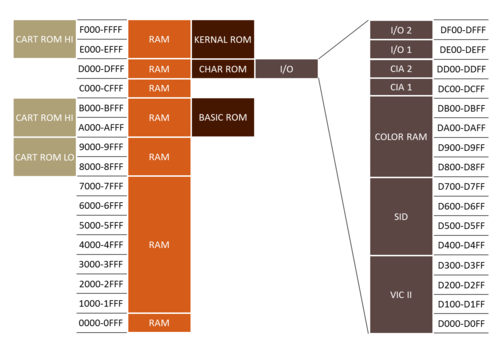Memory Map
The following article shows a short overview of the C64 memory map (pages and memory addresses) as seen by its CPU. The address space may look different from the view of other chips such as the VIC.
This overview shows the status after power on of the C64 in the standard memory configuration ($37/55 in memory address $01, no cartridge).
Detailed descriptions of every memory area can be found in the associated articles.
The memory management is implemented mostly by the C64 PLA.
Overview[edit | edit source]

The diagram on the right displays the addressable locations, and therefore the likely layout, of all memory within the C64. The following notes are meant to be cursory and provide direction to more detailed accounts.
Configurations[edit | edit source]
The default configuration is for KERNAL ROM, I/O, BASIC ROM and the remaining RAM banks to be visible to the CPU. All configurations depend upon the state of latch bits set in the Programmable Logic Unit (PLA). The 7 distinct RAM banks are the smallest zones which can be bank switched.
ROM vs RAM[edit | edit source]
If ROM is visible to the CPU during a write procedure, the ROM will be read but, any data is written to the the underlying RAM. This principle is particularly significant to understanding how the I/O registers are addressed.
Cartridge ROM[edit | edit source]
If cartridge ROM is present it can be located in up to three addressable locations. However, only two 8 kByte banks can be seen by the CPU at any time.
BASIC RAM[edit | edit source]
The BASIC program storage space crosses the boundaries of RAM zones, sitting between $0800-$9FFF (38911 BASIC bytes)
Memory Details[edit | edit source]
The exact content and purpose of each memory bank can be found in the RAM Table, ROM Table and I/O Table below.
RAM Table[edit | edit source]
| Hex Address | Dec Address | Page | Contents |
|---|---|---|---|
| $0000-$00FF | 0-255 | Page 0 | Zeropage addressing |
| $0100-$01FF | 256-511 | Page 1 | Enhanced Zeropage contains the stack |
| $0200-$02FF | 512-767 | Page 2 | Operating System and BASIC pointers |
| $0300-$03FF | 768-1023 | Page 3 | Operating System and BASIC pointers |
| $0400-$07FF | 1024-2047 | Page 4-7 | Screen Memory |
| $0800-$9FFF | 2048-40959 | Page 8-159 | Free BASIC program storage area (38911 bytes) |
| $A000-$BFFF | 40960-49151 | Page 160-191 | Free machine language program storage area (when switched-out with ROM) |
| $C000-$CFFF | 49152-53247 | Page 192-207 | Free machine language program storage area |
| $D000-$D3FF | 53248-54271 | Page 208-211 | |
| $D400-$D7FF | 54272-54527 | Page 212-215 | |
| $D800-$DBFF | 55296-56319 | Page 216-219 | |
| $DC00-$DCFF | 56320-56575 | Page 220 | |
| $DD00-$DDFF | 56576-56831 | Page 221 | |
| $DE00-$DFFF | 56832-57343 | Page 222-223 | Reserved for interface extensions |
| $E000-$FFFF | 57344-65535 | Page 224-255 | Free machine language program storage area (when switched-out with ROM) |
ROM Table[edit | edit source]
Cartridge ROM only becomes resident if attached to the expansion port on power-up. It is included for completeness as a record of the addresses it occupies as a ROM bank.
| Hex Address | Dec Address | Page | Contents |
|---|---|---|---|
| $8000-$9FFF | 32768-40959 | Page 128-159 | Cartridge ROM (low) |
| $A000-$BFFF | 40960-49151 | Page 160-191 | BASIC interpretor ROM or cartridge ROM (high) |
| $D000-$DFFF | 53248-57343 | Page 208-223 | Character generator ROM |
| $E000-$FFFF | 57344-65535 | Page 224-255 | KERNAL ROM or cartridge ROM (high) |
I/O Table[edit | edit source]
| Hex Address | Dec Address | Page | Contents |
|---|---|---|---|
| $0000-$0001 | 0-1 | - | CPU I/O port - see Zeropage |
| $D000-$D3FF | 53248-54271 | Page 208-211 | VIC-II registers |
| $D400-$D7FF | 54272-55295 | Page 212-215 | SID registers |
| $D800-$DBFF | 55296-56319 | Page 216-219 | Color Memory |
| $DC00-$DCFF | 56320-56575 | Page 220 | CIA 1 |
| $DD00-$DDFF | 56576-56831 | Page 221 | CIA 2 |
| $DE00-$DEFF | 56832-57087 | Page 222 | I/O 1 |
| $DF00-$DFFF | 57088-57343 | Page 223 | I/O 2 |
Links[edit | edit source]
- Mapping the Commodore 64 on Bo Zimmer's Commodore web pages
- All About Your 64 texts including complete ROM disassembly and memory map